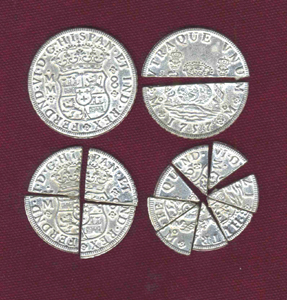DOLLARS... TAXES...
Ownen writes...
So Jim, after much contemplation about the questions facing humanity and me being a mere college student in this large world, I was wondering.... how did the dollar get its name. I mean I have to use so many of them for college; I should know why we call them dollars as opposed to, oh I don't know... greens, or name them by the presidents who are on them.
 Well, Owen, welcome aboard. Coinage, itself has a "rich" history. Many terms in the English language comes from money. A "touchstone" was used to tell how pure gold was which was the first step toward making coins reliable for barter. Before there were American dollars, colonial Americans used coins from England and Spain. The Spanish produced a silver coin in Mexico often referred to as a "reale" or a milled dollar. It became a very common part of the colonial monetary system. It was made to easily make it's own change by cutting into pieces. It could be cut into eight equal pieces, so it was often called "pieces of eight". Each piece was called a "bit" so a quarter would be "two bits". Half a reale was a "picayune". The reale is often given credit for having the first milled edges, those lines on the edge of dimes and quarters, which were first there to prevent the common practice of shaving metal off the edge with the intent of keeping some of the silver.
Well, Owen, welcome aboard. Coinage, itself has a "rich" history. Many terms in the English language comes from money. A "touchstone" was used to tell how pure gold was which was the first step toward making coins reliable for barter. Before there were American dollars, colonial Americans used coins from England and Spain. The Spanish produced a silver coin in Mexico often referred to as a "reale" or a milled dollar. It became a very common part of the colonial monetary system. It was made to easily make it's own change by cutting into pieces. It could be cut into eight equal pieces, so it was often called "pieces of eight". Each piece was called a "bit" so a quarter would be "two bits". Half a reale was a "picayune". The reale is often given credit for having the first milled edges, those lines on the edge of dimes and quarters, which were first there to prevent the common practice of shaving metal off the edge with the intent of keeping some of the silver.However, I totally digress...
 The term "dollar" has it's roots in the medieval county of Bohemia. During the Renaissance, a vast amount of high-quality silver ore was extracted from a mine in Joachimsthal, or the valley of St. Joachim, in what is now known as the Czech Republic. A large coin produced with the silver taken from this mine was called a "Joachimsthaler;" and, as time went by, the first part of this name, "Joachims," was dropped, leaving simply "thaler." Because of the various dialects spoken, pronunciation varied from one region to another. In Holland, for example, this word was pronounced "daalder," from which the English "dollar" is derived.
The term "dollar" has it's roots in the medieval county of Bohemia. During the Renaissance, a vast amount of high-quality silver ore was extracted from a mine in Joachimsthal, or the valley of St. Joachim, in what is now known as the Czech Republic. A large coin produced with the silver taken from this mine was called a "Joachimsthaler;" and, as time went by, the first part of this name, "Joachims," was dropped, leaving simply "thaler." Because of the various dialects spoken, pronunciation varied from one region to another. In Holland, for example, this word was pronounced "daalder," from which the English "dollar" is derived.The United States fashioned there first silver dollar after the Spanish reale, though it was made to have 100 cents rather that eight bits. Of course, the U.S. was not the first to use the term "dollar". "Dollar" pops up in several of Sheakspear's plays. You will probably remember:
Macbeth Act I, Scene 2
Rosse: "That now Sweno, the Norway's King, craves composition. Nor would we deign him burial of his men, till he disbursed at Saint Colme's Inch, ten thousand dollars to our general use."
OR - The Tempest, Act II, Scene 1
Gonzalo: "When every grief is entertain'd that's offer'd, Comes to th' entertainer -
Sebastian: "A dollar."
Gonzalo: "Dolour comes to him, indeed: you have spoken truer than you purpos'd."
The last remark by Gonzalo was, of course, a pun since "dolour" is an old-fashioned word for pain or grief, like the modern Spanish word dolor, which also means pain. Oh that wild and whacky Sheakspear!
Of course, the greatest literary allusion to the dollar is from the funniest movie ever made: the 1933 Marx brothers production of Duck Soup:
Minister of Defense: "Your Excellency, General Cooper says Sylvanian troops are about to land on Fredonian soil. This means war!"
Minister of Finance: "Something must be done! War would mean a prohibitive increase in our taxes."
Chicolini: "Hey, I got an uncle lives in Taxes."
Minister of Finance: "No, I'm talking about money... Dollars!... Taxes!."
Chicolini: "Dollas! There's-a where my uncle lives. Dollas, Taxes! Atsa some joke eh, boss?"



0 Comments:
Post a Comment
<< Home